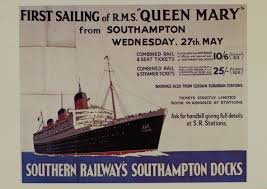The young Ahdieh from Nayriz departed for the United States from Southampton, which had been the home port of the Titanic, the sinking of which left hundreds of Southampton families bereft, and which ‘Abdu’l-Baha had been encouraged to travel on before turning it down. The huge Queen Mary carried more people than lived in Ahdieh’s small hometown. The crossing $50 in the early 1960s and took six days.
The Queen Mary
Entering the ship entered the port of New York and seeing the Statue of Liberty come into view, he thought about how far he’d travelled and felt close to the millions of immigrants who had fled religious and political persecutions.
How much more of a shock such a site must have been for Haji Sayyah, “The Traveller,” who had arrived in New York City in 1867 from Central Asia. He was the first Iranian to receive American citizenship.
Elli Island, immigrant center
Baha’is had an even greater motive for immigrating when, in the mid-‘50s, a prominent cleric unleashed a national campaign of persecution via the radio. He incite Muslims to take action against their Baha’i neighbors. His sermons were especially virulent during the season of Ramadan, a season of supposed restraint and fasting.
The Baha’i national center was occupied and its dome demolished. In the village of Hurmuzdak in the Province of Yazd, seven Baha’is—ages nineteen to eighty—were hacked to pieces with spades and axes by a mob of villagers. These persecutions were stopped by only when they brought unwanted international scrutiny.
Many Baha’is who emigrated from Iran during the 1950s to teach the faith and fulfill the international plans of Shoghi Effendi. After 1979, the 16,000 or more Iranian Baha’is who came to North America were fleeing the persecution unleashed by the Islamic Revolution.
The town of Nayriz was virtually depopulated of Baha’is after that year with only a few impoverished Baha’i families remaining who could not afford to leave.
Version of One Hundred Thousand Veils composed by Luke Slott

